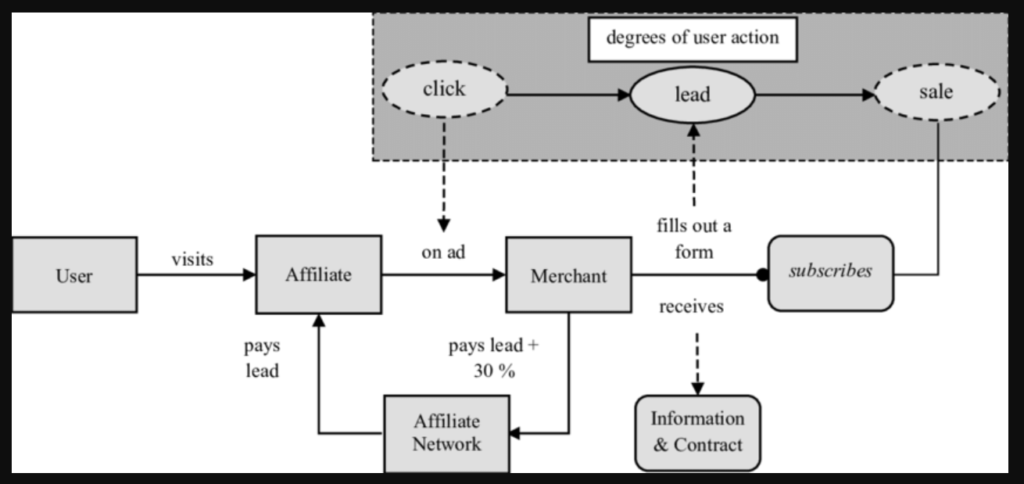Table of Contents
Introduction
Unlocking affiliate success is a journey that requires careful planning, strategic execution, and continuous improvement. In the ever-evolving landscape of affiliate marketing, understanding key concepts and implementing effective strategies can make all the difference. This blog post will guide you through essential topics, including choosing your niche, building your online presence, creating engaging content, optimizing for search engines, and analyzing your performance. By following these insights, you’ll be well-equipped to navigate the challenges of affiliate marketing and achieve your goals.
What is Affiliate Marketing? A Comprehensive Introduction

Affiliate marketing is a performance-based marketing strategy where businesses reward individuals (affiliates) for driving traffic or sales to their products through the affiliate’s marketing efforts. In simple terms, it’s a way for individuals to earn money by promoting someone else’s products or services.
How Affiliate Marketing Works
The process of affiliate marketing typically involves three key players:
- The Merchant: This is the business or individual selling the product or service. They create an affiliate program to incentivize affiliates.
- The Affiliate: This is you, the marketer, who promotes the merchant’s products using various marketing techniques. Affiliates earn a commission for every sale or lead generated through their unique referral link.
- The Customer: The end user who clicks on the affiliate’s link and makes a purchase. This is the ultimate goal—driving customers to the merchant.
The Benefits of Affiliate Marketing
- Low Startup Costs: Unlike traditional businesses, affiliate marketing such impact radius requires minimal upfront investment, making it accessible to anyone.
- Flexibility: Affiliates can work from anywhere and choose their own hours, allowing for a great work-life balance.
- Passive Income Potential: Once established, affiliates can earn money even when they are not actively promoting products.
Why is Affiliate Marketing Popular?
The rise of e-commerce has significantly contributed to the popularity of affiliate marketing. With more consumers shopping online, businesses are increasingly turning to affiliates to expand their reach without the overhead costs of traditional advertising. This symbiotic relationship benefits all parties involved, making affiliate marketing a powerful tool for unlocking affiliate success.
Choosing Your Niche: The Key to Affiliate Success

in unlocking Affiliate Success, selecting the right niche is a crucial step in unlocking affiliate success. A niche is a specific segment of the market that focuses on a particular interest or topic. By choosing a niche that aligns with your passions and expertise, you increase your chances of connecting with your audience and driving sales.
Why Choosing the Right Niche Matters
- Targeted Audience: A well-defined niche allows you to tailor your content and marketing strategies to a specific group of people. This targeted approach helps you attract an audience that is genuinely interested in what you have to offer.
- Less Competition: While popular niches can be lucrative, they often come with high competition. By finding a less saturated niche, you can position yourself as an authority more easily and stand out among your peers.
- Higher Engagement: When you choose a niche that you are passionate about, it shows in your content. Your enthusiasm will resonate with your audience, leading to higher engagement and conversion rates.
How to Choose Your Niche
- Identify Your Interests and Expertise: Start by listing topics you are passionate about or have knowledge in eg. graphic design. This will help ensure that you remain motivated and engaged in your affiliate marketing efforts.
- Research Market Demand: Use tools like Google Trends, keyword planners, and social media platforms to evaluate the popularity of your potential niches. Look for topics that have a growing interest and a steady demand.
- Analyze the Competition: Investigate existing affiliates and competitors in your chosen niche. Analyze their content, marketing strategies, and audience engagement. This research can provide insights into what works and how you can differentiate yourself.
- Consider Profitability: Finally, assess the earning potential of your niche. Look for affiliate programs that offer competitive commissions and high-quality products. A niche that aligns with consumer spending habits can significantly boost your income.
Testing Your Niche
Once you’ve narrowed down your options, consider testing your niche by creating a small amount of content and promoting it. Monitor engagement metrics such as traffic, click-through rates, and conversions. This will help you validate your choice before fully committing
NOTE: Choosing the right niche is the foundation of unlocking affiliate success. By focusing your efforts on a specific area, you can create content that resonates with your audience, driving engagement and profitability. As you continue your journey, keep refining your niche to adapt to market changes and audience needs.
Building Your Online Presence: Essential Steps
in unlocking Affiliate Success, establishing a strong online presence is vital for unlocking affiliate success. Your online presence not only helps you build credibility but also allows you to connect with your audience effectively. Here are essential steps to help you create a compelling online presence.
1. Create a Professional Website
Your website serves as the cornerstone of your online presence. It’s where you share your content, promote products, and engage with your audience. Here are some key elements to consider:
- User-Friendly Design: Choose a clean, responsive design that is easy to navigate. Make sure your website is mobile-friendly to accommodate users on all devices.
- Quality Content: Focus on creating high-quality, valuable content that addresses your audience’s needs. This could include blog posts, reviews, tutorials, and more.
- Clear Branding: Develop a consistent brand identity, including a memorable logo, color scheme, and voice. This helps establish trust and recognition among your audience.
2. Leverage Social Media Platforms
Social media is a powerful tool for building your online presence. It allows you to reach a wider audience and engage with them directly. Here’s how to effectively use social media:
- Choose the Right Platforms: Identify which social media platforms your target audience frequents. Focus your efforts on those channels to maximize engagement.
- Consistent Posting: Share content regularly to keep your audience engaged. Use a content calendar to plan and schedule your posts in advance.
- Engagement: Respond to comments and messages promptly. Engaging with your audience builds relationships and fosters community.
3. Utilize Email Marketing

Email marketing is an effective way to nurture your audience and drive conversions. Here are some essential practices:
- Build an Email List: Offer valuable incentives, such as free eBooks or exclusive content, to encourage visitors to sign up for your newsletter.
- Segment Your Audience: Organize your email list into segments based on interests or behaviors. This allows you to send targeted content that resonates with each group.
- Regular Newsletters: Send out regular newsletters with updates, tips, and promotions. This keeps your audience informed and engaged.
4. Optimize for Search Engines
In unlocking Affiliate Success, SEO is crucial for increasing your visibility online. Here are key SEO practices to implement:
- Keyword Research: Use tools to identify relevant keywords related to your niche. Incorporate these keywords naturally into your content.
- On-Page SEO: Optimize your website’s title tags, meta descriptions, and headings. Ensure your content is well-structured and easy to read.
- Link Building: Build backlinks from reputable sources to improve your site’s authority. Guest blogging and collaborations can help you achieve this.
Content Creation Strategies: Engaging Your Audience

Creating engaging content is essential for unlocking affiliate success. Quality content not only attracts visitors but also keeps them coming back for more. Here are effective content creation strategies to help you engage your audience effectively.
1. Know Your Audience
Understanding your audience is the first step in creating content that resonates. Here’s how to do it:
- Define Your Target Demographic: Identify the characteristics of your ideal audience, including age, gender, interests, and challenges. This will help you tailor your content to meet their needs.
- Gather Feedback: Use surveys, polls, or direct engagement on social media to gather insights about what your audience wants to learn or discuss.
2. Create High-Quality, Valuable Content
Quality is key when it comes to content creation. Focus on delivering value through your content:
- Informative Blog Posts: Write in-depth articles that provide solutions to common problems faced by your audience. Use the focus keyword “Unlocking Affiliate Success” where relevant to enhance SEO.
- Visual Content: Incorporate images, infographics, and videos to make your content more engaging. Visuals can simplify complex information and keep readers interested.
3. Utilize Different Content Formats
Varying your content formats can help you reach a broader audience and maintain engagement:
- How-To Guides: Create step-by-step guides that provide actionable insights. This format is particularly effective for affiliate marketing as it can showcase products in a practical context.
- Listicles: Articles structured as lists (e.g., “Top 10 Tips for Affiliate Marketing”) are easy to read and digest. They often attract higher engagement due to their straightforward format.
- Case Studies and Testimonials: Share success stories or testimonials from customers who have benefited from products you promote. This builds credibility and trust.
4. Optimize for SEO
To ensure your content reaches your target audience, optimize it for search engines for unlocking Affiliate Success.
- Keyword Integration: Naturally incorporate relevant keywords throughout your content, including in titles, headers, and meta descriptions. This helps improve your rankings in search results.
- Internal and External Links: Include links to relevant pages on your site and authoritative external sources. This can enhance the credibility of your content and improve SEO.
5. Encourage Interaction
Engaging your audience goes beyond just delivering content. Encourage interaction to build a community:
- Call to Action (CTA): End your posts with a clear CTA, inviting readers to comment, share, or sign up for your newsletter. This fosters engagement and interaction.
- Comment Sections: Monitor and respond to comments on your blog. Engaging with your readers can create a sense of community and loyalty.
SEO Best Practices: Optimizing for Search Engines

Optimizing your content for search engines is crucial for unlocking affiliate success. Effective SEO (Search Engine Optimization) helps improve your website’s visibility, driving organic traffic and increasing your chances of conversion. Here are essential SEO best practices to implement.
1. Conduct Keyword Research
Keyword research is the foundation of effective SEO. Here’s how to do it:
- Identify Relevant Keywords: Use tools like Google Keyword Planner, Ahrefs, or SEMrush to find keywords related to your niche. Focus on long-tail keywords that have lower competition and higher intent.
- Analyze Search Intent: Understand what users are looking for when they search for your target keywords. This can guide your content creation to meet their needs effectively.
2. Optimize On-Page Elements
On-page SEO refers to optimizing individual pages on your website. Key elements to focus on include:
- Title Tags: Ensure your title tags are clear, descriptive, and include the focus keyword “Unlocking Affiliate Success.” This helps search engines understand the content of your page.
- Meta Descriptions: Write compelling meta descriptions that summarize your content and include relevant keywords. Although meta descriptions don’t directly affect rankings, they can improve click-through rates.
- Header Tags: Use header tags (H1, H2, H3) to structure your content. Include keywords in your headers to signal to search engines the main topics covered in your article.
3. Create High-Quality Content
Content quality is paramount for SEO. Focus on creating valuable, informative content that meets your audience’s needs:
- Length and Depth: Longer, in-depth articles tend to perform better in search rankings. Aim for comprehensive coverage of topics while maintaining readability.
- Internal Linking: Link to other relevant pages on your website within your content. This helps search engines understand your site’s structure and keeps users engaged longer.
4. Improve Site Performance
A fast and user-friendly website enhances the overall user experience and is favored by search engines:
- Page Speed: Use tools like Google PageSpeed Insights to test and improve your site’s loading speed. Optimize images and minimize code to enhance performance.
- Mobile Optimization: Ensure your website is mobile-responsive. A significant portion of web traffic comes from mobile devices, and search engines prioritize mobile-friendly sites.
5. Build Quality Backlinks
Backlinks from reputable websites signal to search engines that your content is valuable:
- Guest Blogging: Contribute articles to reputable blogs in your niche, including links back to your site. This can help you gain visibility and authority.
- Collaborate with Influencers: Partner with influencers or other content creators to expand your reach and earn backlinks.
Analyzing Performance: Tools and Metrics for Growth
Analyzing your performance is essential for unlocking affiliate success. By monitoring key metrics and utilizing the right tools, you can gain insights into what works and what doesn’t, allowing you to make informed decisions for growth. Here are the essential tools and metrics you need to focus on.
1. Key Performance Indicators (KPIs)
Establishing KPIs will help you measure your success and identify areas for improvement. Here are some crucial metrics to track:
- Traffic Sources: Understand where your website traffic is coming from (organic, social media, referrals, etc.). This helps you identify which channels are most effective.
- Conversion Rate: Calculate the percentage of visitors who complete a desired action, such as making a purchase or signing up for a newsletter. A high conversion rate indicates effective marketing and content.
- Click-Through Rate (CTR): Measure the percentage of users who click on your affiliate links compared to the total number of visitors. A high CTR suggests your calls to action are effective.
2. Google Analytics
Google Analytics is a powerful tool for tracking website performance. Here’s how to use it effectively:
- Set Up Goals: Define specific goals in Google Analytics to track conversions, such as purchases or sign-ups. This will help you measure your success against your KPIs.
- Analyze User Behavior: Use the behavior flow report to see how users navigate your site. This can help you identify bottlenecks or pages that need improvement.
- Monitor Audience Insights: Gain insights into your audience demographics, interests, and behaviors. This information can guide your content and marketing strategies.
3. Affiliate Network Dashboards
Many affiliate networks provide their own dashboards to track performance metrics. Key features to look for include:
- Real-Time Reporting: Access real-time data on clicks, conversions, and commissions. This allows you to respond quickly to trends and optimize your strategies.
- Performance Comparisons: Compare your performance against other affiliates or industry benchmarks. This can help you identify areas for improvement and set realistic goals.
4. A/B Testing Tools
A/B testing is a valuable method for optimizing your content and marketing strategies:
- Experiment with Variations: Use tools like Optimizely or Google Optimize to test different versions of your landing pages, calls to action, or email campaigns. Analyze which variations yield better results.
- Data-Driven Decisions: Use the insights from your A/B tests to make informed decisions about your content and marketing strategies, enhancing overall performance.
5. Social Media Analytics

If you’re leveraging social media to promote your content, use social media analytics tools to track performance:
- Engagement Metrics: Monitor likes, shares, comments, and overall engagement rates. This helps you understand which content resonates with your audience.
- Follower Growth: Track your follower growth over time to assess the effectiveness of your social media strategies.
NOTE: By effectively analyzing your performance using these tools and metrics, you can unlock affiliate success and drive sustainable growth. Regularly review your data, adapt your strategies based on insights, and continue to refine your approach for ongoing improvement.
Conclusion
In the fast-paced world of affiliate marketing, unlocking affiliate success requires a strategic approach that encompasses various elements. From choosing the right niche and building a solid online presence to creating engaging content and optimizing for search engines, each step plays a crucial role in your overall performance.
By implementing effective content creation strategies and utilizing powerful analytical tools, you can gain valuable insights into your audience and continually refine your approach. Remember, the key to long-term success lies in staying adaptable, consistently evaluating your performance, and being open to change.
As you embark on your affiliate marketing journey, keep these strategies and best practices in mind. With dedication and the right tactics, you can achieve your goals and thrive in this competitive landscape. Start today, and take the first step toward unlocking your affiliate success!


